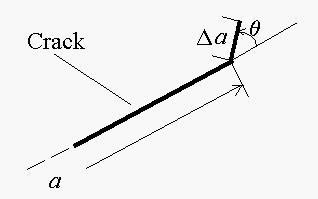DETERMINATION OF FRACTURE PROPAGATION USING DDM
The key step in using the F-criterion is to determine the strain energy release rate of mode I (GI) and mode II (GII) at a given fracture tip. As GI and GII are only the special cases of G, the problem is then how to use DDM to calculate the strain energy release rate G.
The G-value, by definition, is the change of the strain energy in a linear elastic body when the crack has grown one unit of length. Therefore, to obtain the G-value the strain energy must first be estimated.
By definition, the strain energy, W, in a linear elastic body is
 2-19
2-19
where σij and εij are the stress and strain tensors, and V is the volume of the body. The strain energy can also be calculated from the stresses and displacements along its boundary
 2-20
2-20
where σs, σn, us, un are the stresses and displacements in tangential and normal direction along the boundary of the elastic body. Applying Equation 2-20 to the crack system in an infinite body with far-field stresses in the shear and normal direction of the crack, (σs)0 and (σn)0, the strain energy, W, in the infinite elastic body is
 2-21
2-21
where a is the crack length, Ds is the shear displacement discontinuity and Dn is the normal displacement discontinuity of the crack. When DDM is used to calculate the stresses and displacement discontinuities of the crack, the strain energy can also be written in terms of the element length (ai) and the stresses and displacement discontinuities of the ith element of the crack.
 2-22
2-22
The G-value can be estimated by
 2-23
2-23
where W(a) is the strain energy governed by the original crack while W(a+Da) is the strain energy governed by both the original crack, a, and its small extension, Da (Figure 2-4). In Figure 2-4, a 'fictitious' element is introduced to the tip of the original crack with the length Da in the direction θ. Both W(a) and W(a+Da) can be determined easily by directly using DDM and Equation 2-23.

Figure 2-4. Fictitious crack increment a in direction with respect to the initial crack orientation.
In the above calculation, if we restrict numerically the shear displacement of the "fictitious" element to zero, the result obtained using Equation 2-23 will be GI(q). Similarly, if we restrict the normal displacement of the "fictitious" element to zero, the result obtained will be GII(q). After obtaining both GI(q) and GII(q), the F-value in Equation 2-16 can be calculated using the given fracture toughness values GIc and GIIc of a given rock type.